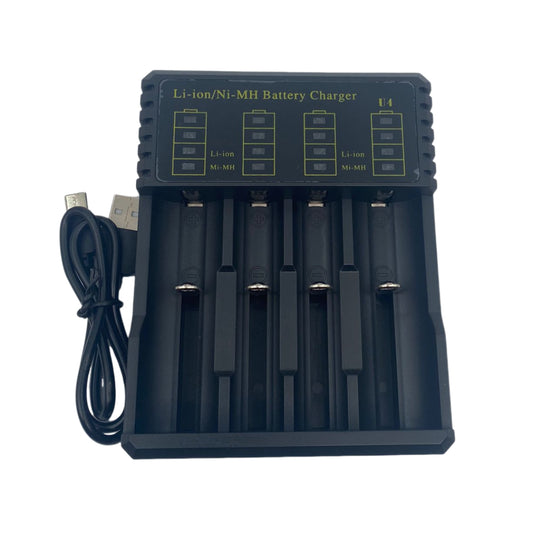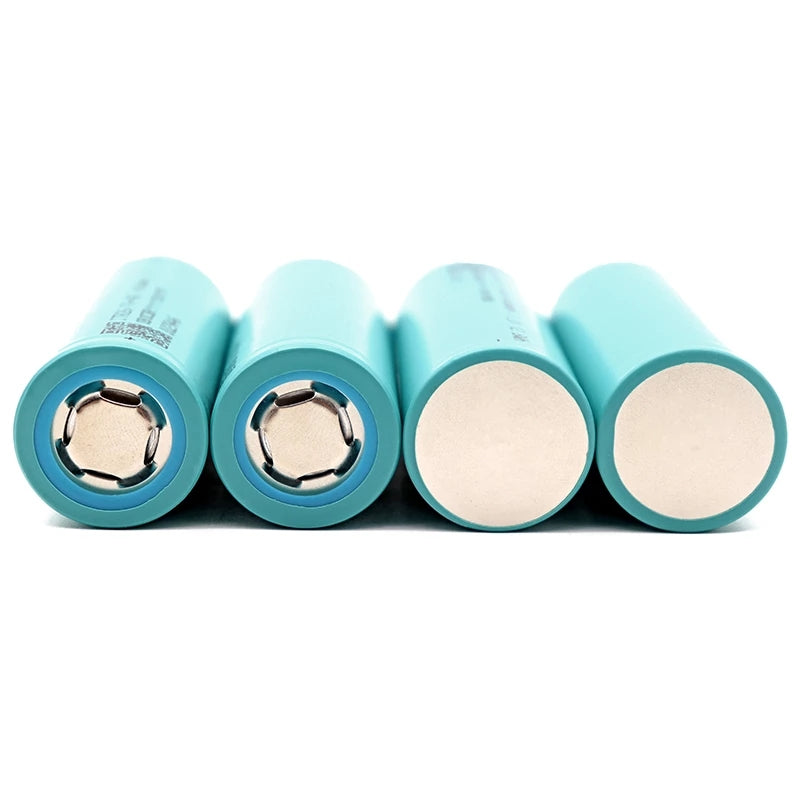-
Proveedor:BATTERYINT
2 piezas de batería 26650 de 5000 mAh a 5500 mAh, 3,7 V, ion de litio para banco de energía con linterna
- Precio habitual
- $12.99
- Precio habitual
-
- Precio de venta
- $12.99
- Precio unitario
- por
2 piezas de batería 26650 de 5000 mAh a 5500 m... -
Proveedor:BATTERYINT
2 piezas 26650 batería recargable 3,7 V 8800 mAh batería de iones de litio, utilizada para linterna
- Precio habitual
- $13.99
- Precio habitual
-
- Precio de venta
- $13.99
- Precio unitario
- por
2 piezas 26650 batería recargable 3,7 V 8800 m... -
Proveedor:BATTERYINT
2 piezas de batería de iones de litio 26650A 3,7 V 5000 mAh
- Precio habitual
- $15.99
- Precio habitual
-
- Precio de venta
- $15.99
- Precio unitario
- por
2 piezas Batería de iones de litio 26650A 3,7 V... -
Proveedor:BATTERYINT
2 piezas 26650 5000mAh 3,7V 26650 batería de iones de litio con parte superior plana para linterna frontal
- Precio habitual
- $24.99
- Precio habitual
-
- Precio de venta
- $24.99
- Precio unitario
- por
2 piezas 26650 5000mAh 3,7V 26650 batería de i... -
Proveedor:BATTERYINT
4 piezas 3,2 V 26700 4000 mAh batería lifepo4 para paquete 10A hoja de descarga
- Precio habitual
- $19.80
- Precio habitual
-
- Precio de venta
- $19.80
- Precio unitario
- por
4 piezas 3,2 V 26700 4000 mAh batería lifepo4 p... -
Proveedor:BATTERYINT
2 piezas 26650 5000mAh batería de iones de litio de alta capacidad Lii-50A 3,7 V 26650-50A batería de linterna 20A nuevo embalaje
- Precio habitual
- $18.99
- Precio habitual
-
- Precio de venta
- $18.99
- Precio unitario
- por
2 piezas 26650 5000mAh batería de iones de liti... -
Proveedor:BATTERYINT
4 piezas 3,2 V 26650 batería recargable LiFePO4 3200 mAh batería de litio IFR 26650
- Precio habitual
- $19.90
- Precio habitual
-
- Precio de venta
- $19.90
- Precio unitario
- por
4 piezas 3,2 V 26650 batería recargable LiFePO4... -
Proveedor:BATTERYINT
4 baterías de gran capacidad 26650 de 7200 mAh y 3,7 V de iones de litio para linternas nuevas
- Precio habitual
- $23.99
- Precio habitual
-
- Precio de venta
- $23.99
- Precio unitario
- por
Batería de gran capacidad 26650 de 4 piezas, 72... -
Proveedor:BATTERYINT
Batería de iones de litio recargable 26650 de 3,7 V y 5000 mAh con placa protegida para linterna LED
- Precio habitual
- $14.56
- Precio habitual
-
- Precio de venta
- $14.56
- Precio unitario
- por
Batería de iones de litio recargable 26650 d...
Demostración 1 -9 de 9 elementos
1. ¿Qué es una batería de litio 26650?
Una batería de litio 26650 es una batería de iones de litio recargable que es más grande y más potente que otras baterías de litio comunes, como la 18650. Recibe su nombre de sus dimensiones: 26 mm de diámetro y 65 mm de longitud. La batería 26650 normalmente tiene un voltaje nominal de 3,6 V a 3,7 V y se utiliza ampliamente en dispositivos que requieren una alta potencia de salida y un tiempo de funcionamiento prolongado, como herramientas eléctricas, bicicletas eléctricas, linternas de alta luminosidad e incluso algunas estaciones de energía portátiles. Su mayor tamaño permite una mayor capacidad de energía, lo que la convierte en una opción ideal para aplicaciones de alto consumo.
2. ¿Cuánta capacidad proporciona una batería 26650?
Una batería 26650 ofrece un rango de capacidad de 3000 mAh a 5000 mAh, y algunos modelos de alta capacidad alcanzan hasta 6000 mAh. Esta alta capacidad significa que la batería puede almacenar más energía, lo que le permite alimentar dispositivos durante períodos más prolongados. Por ejemplo, en una linterna de alta potencia, una batería de iones de litio 26650 completamente cargada puede proporcionar un brillo prolongado durante 8 a 12 horas, mientras que en dispositivos de menor potencia, puede durar varios días. Los dispositivos que requieren un mayor suministro de energía, como las bicicletas eléctricas o las herramientas eléctricas, se benefician del mayor almacenamiento de energía que ofrecen las baterías 26650.
3. ¿Cuál es la diferencia entre la batería 21700 y la 26650?
La principal diferencia entre ambas es el tamaño. La batería 21700 tiene 21 mm de diámetro y 70 mm de longitud, mientras que la batería 26650 tiene 26 mm de diámetro y 65 mm de longitud. La batería recargable 26650 también tiene mayor capacidad y mayor autonomía.
4. título de preguntas frecuentes
The longevity of a 26650 rechargeable battery depends on its capacity and the power consumption of the device it is powering. In high-drain devices such as power tools, the battery may last from 30 minutes to 2 hours of continuous use. However, in lower-power applications like LED flashlights or portable fans, a fully charged 26650 lithium battery can last anywhere from 8 to 24 hours, depending on the energy demand. On average, 26650 batteries can go through 300 to 500 charge cycles before their capacity significantly declines, though high-quality models may exceed this number.
5. ¿Cómo puedo prolongar la vida útil de una batería li ion 26650?
Para prolongar la vida útil de su batería de iones de litio 26650, evite agotarla por completo durante su uso, ya que las descargas profundas pueden forzar las celdas de la batería y reducir su vida útil total. Lo mejor es recargar la batería cuando caiga a alrededor del 20% de su capacidad. Además, evite exponer la batería a temperaturas extremas, ya que tanto el calor como el frío pueden dañar su estructura interna. Cuando no esté en uso, guarde la batería recargable 26650 a temperatura ambiente, idealmente con una carga de alrededor del 50%, lo que ayuda a evitar el estrés innecesario en las células. El uso de un cargador de alta calidad con protección contra sobrecarga también puede prolongar la vida útil de la batería al evitar la sobrecarga.
6. Cómo puedo cargar de forma segura una batería de litio 26650?
Para cargar una batería Li-Ion 26650 se necesita un cargador compatible que proporcione una tensión de carga estable de 4,2 V. Es importante elegir un cargador con la corriente de salida correcta para su batería. Para la mayoría de las pilas recargables 26650, lo ideal es un cargador que ofrezca una corriente de salida de 1A a 2A. Cargar la batería con una corriente superior a la recomendada puede provocar un sobrecalentamiento y, potencialmente, dañar la batería. Muchos cargadores modernos incluyen funciones de seguridad como el apagado automático y la protección contra sobrecarga, que evitan que la batería se sobrecargue, garantizando que permanezca segura durante la carga.
7. ¿Son seguras las pilas de litio 26650?
Sí, las pilas de litio 26650 son seguras si se utilizan correctamente y con dispositivos compatibles. La mayoría de las pilas recargables 26650 de alta calidad vienen con mecanismos de seguridad incorporados, como protección contra sobrecarga, protección contra cortocircuitos y prevención de sobredescarga. Estas características garantizan que la batería funcione dentro de parámetros seguros, minimizando el riesgo de sobrecalentamiento o mal funcionamiento. Sin embargo, como todas las baterías de iones de litio, deben manipularse con cuidado. Es importante evitar exponer la batería 26650 a temperaturas extremas, pinchazos o daños físicos, ya que pueden provocar riesgos para la seguridad. Utilizar el cargador correcto y seguir las directrices del fabricante aumenta aún más la seguridad.
8. ¿Se pueden reciclar las pilas 26650?
Sí, las pilas 26650 pueden y deben reciclarse para reducir el impacto medioambiental y recuperar materiales valiosos como el litio, el cobalto y el níquel. Las instalaciones de reciclaje tratan específicamente las pilas de iones de litio, garantizando que se procesan de forma segura. Una eliminación inadecuada, como tirar las pilas de litio 26650 a la basura normal, puede ser perjudicial para el medio ambiente debido a la posible fuga de sustancias químicas. Muchos programas locales de reciclaje o centros de residuos electrónicos aceptan pilas recargables 26650 para su correcta eliminación y reciclaje, lo que facilita la contribución a los esfuerzos de sostenibilidad.
9. ¿Cuánto tiempo se puede almacenar una batería 26650?
Si se almacena correctamente, una batería 26650 puede conservar la mayor parte de su carga durante varios meses o un año. Las baterías de litio 26650 tienen una tasa de autodescarga baja, de aproximadamente el 2 % al 5 % por mes, lo que significa que pierden poca energía mientras están almacenadas. Sin embargo, para el almacenamiento a largo plazo, es mejor mantener la batería con una carga de entre el 40 % y el 60 %. Almacenarla con carga completa o completamente agotada puede forzar las celdas de la batería, lo que reduce su vida útil general. El entorno de almacenamiento ideal es fresco, seco y alejado de la luz solar directa, con temperaturas entre 15 °C y 25 °C (59 °F y 77 °F), lo que ayuda a mantener la salud de la batería.
10. ¿Cómo se compara una batería de iones de litio 26650 con una batería 18650?
Si bien tanto las baterías de litio 26650 como las baterías 18650 se utilizan en dispositivos de alto consumo, las principales diferencias radican en el tamaño y la capacidad. La batería 26650 es físicamente más grande, lo que le permite almacenar más energía que la batería 18650. Por ejemplo, la batería 18650 típica tiene un rango de capacidad de 2000 mAh a 3500 mAh, mientras que las baterías 26650 pueden alcanzar capacidades de hasta 5000 mAh o más. Esto significa que los dispositivos alimentados por baterías recargables 26650 pueden funcionar durante más tiempo entre cargas. Aunque ambas baterías ofrecen salidas de voltaje similares de alrededor de 3,7 V, la batería 26650 suele preferirse para aplicaciones que demandan más energía durante períodos más prolongados.































